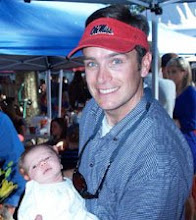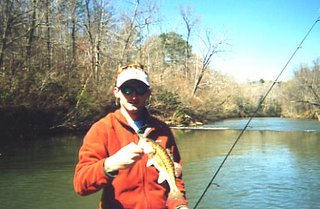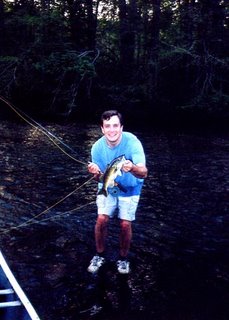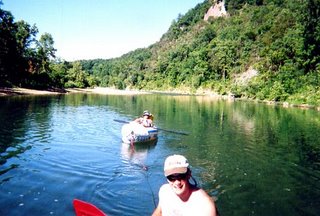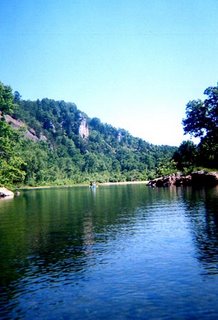
Tallapoosa River
The Tallapoosa River forms near Buchanan, Georgia at an elevation near 1,200 feet. The headwaters are approximately 40 miles west of Atlanta. Here it is mostly wade fishing for Redeye and Spotted Bass with good water quality. This Piedmont stream begins to take on a much more pastoral nature near Tallapoosa, Georgia.
The Tallapoosa then flows generally southwest in to Alabama just north of I-20 at an elevation of 900 feet. The water becomes more stained, but the river still cuts through some scenic bluffs lined with Mountain Laurel. The rock formations are igneous and metamorphic. They often appear folded and faulted along the deep river bends. The river is generally placid and floatable most of the year, all the way to Lake Wedowee. The gradient in the 18.7 mile stretch from the Georgia line to I-20 is 2.6 feet per mile. There are occasional minor rapids and ripples that occur below I-20. The gradient below I-20 is 3.74 feet per mile. Also, you can find occasional gravel bars for river camping. The 44 mile stretch above Lake Wedowee has been designated as the Loyd Owens Canoe Trail. There is an outfitter, Lex Brown at Tallapoosa River Outfitters, who makes this float very convenient.

Doc Looks Downstream
Trip Report
It was late May and the streams of Alabama were setting into typical summerlike levels. Curtis Wright and I were looking for a overnight canoe camping river in Alabama with an outfitter service. Temperatures were also heating up and we wanted to get far enough north for pleasant overnight temperatures. The only other option was the Cahaba and this looked more interesting. I have not ever floated a piedmont stream and figured this was a good opportunity to experience a new area in the state. We loaded up the truck with my Explorer canoe, Curtis' Necky sea kayak, canoe camping gear, and my dog Doc and headed north. We floated on a section of Choccolocco Creek (running 600 cfs) on Friday and camped at Cheaha on Friday night. Saturday morning, we met Lex Brown (256-239-6399) at Tallapoosa River Outfitters.
Day One
Access at Liner Road Bridge-Campsite above I-20
Distance 15.25 miles
Lex helped us load our boats and gear on his Chevy Suburban and took us to the Liner Road Bridge near Tallapoosa Georgia. His shuttle service allowed for us to paddle a 26 mile trip through a remote section of the river. It hadn't rained in 6-7 days and the river was running just under 4 feet (380 cfs) on the USGS gauge. On Saturday morning, we began fishing along the Georgia/Alabama line and I caught a decent 1 pound spotted bass on my first cast. He hit a 4" finesse worm rigged Texas style. This was a bad omen. We didn't catch another fish until after lunchtime. And, we fished very hard.

Gear, Dog, and Redeye Bass
I finally switched to a small beetle spin and picked up a decent 3/4 pound Redeye Bass. I released both the spot and the Redeye. We had plans to have fish for dinner, but initially it seemed that catching a few fresh fish in the evening wouldn't be problem.
Fishing hard, and paddling very little, we average about one mile per hour as we floated through a low gradient section of the Tallapoosa. This upper section was mostly forested. A railroad track follows the river on the north side for the first 2.5 miles. Also, we noticed a Georgia State flag dangling across the river on a rope, at what was presumably the state line at mile 1.2. The river had a clarity of about three feet with a muddy tint. There were very long stretches between riffles. In the long flat stretches, the water averaged 3-4 feet in depth. The banks were muddy and lined with fallen trees.
We saw a large number of wood ducks. I trained Doc, my lab, to hunt ducks with me in the winter. He was very eager to keep track of all the waterfowl. Occasionally, we would encounter small rock bluff areas, and blooming laurels. The water clarity seemmed to improve in the small riffle and shoal areas. The upper river probably would have been more memorable if the fishing was better. Curtis and I felt that the fish were there, they just weren't biting.

Upper River
After an MRE lunch, the fishing picked up somewhat. I had nice battle with a 4-5 pound flathead catfish that hit a 1/4 ounce spinnerbait. I lost the fish on a stump in mid-river towards the end of the fight. I was also surprised to catch a Rock Bass on the spinnerbait. As the afternoon progressed, the I switched to a beetle spin and picked up numerous redbreast and bluegills in efforts to catch dinner. At mile 8.0, we squeezed passed a log jam at the CR49 bridge.
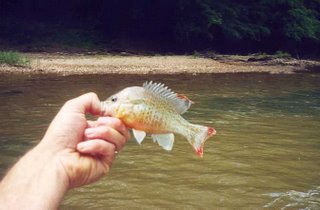
Redbreast Sunfish
Fortunately, Curtis stayed with the worm. He caught a nice 2 1/2 pound spot. We didn't get a picture of it. He said it was a very tough fight that lasted several minutes. So, with dinner on the stringer, we picked up the pace with our paddling.

Redear Sunfish
We passed the Dryden's Mill campsite and access at mile 12.5. It was loud with music, crowded with vehicles and local kids. We pushed on. After paddling a total of 15.5 miles for the day, we camped about one mile below the CR 66 bridge. We found a decent campsite on a gravel bar on river left. Two deer were on the site as we approached. The bugs weren't too bad. We had the ThermaCell going just in case. Curtis' fish ended up getting lightly battered, and pan fried for dinner. It was very good table fare. In addition to the fish, I cooked some Orzo with peppers and onions. It was tasty.
Day Two
Campsite above I-20 to Bell Mills

Curtis Runs a I-II Rapid in the Necky
After a nice breakfast of bacon, eggs, and grits... We paddled and fished on, at a bit faster rate through the remainder of the trip. The gradient increases to almost four feet per mile below I-20. The scenery was a little better through this stretch. We also caught more fish. I stayed with the standby 1/8oz roostertail spinner on my Loomis ultralight. I had no trouble catching various sunfish species. We caught mostly redbreast and bluegills. I did catch one redear sunfish (shellcracker). Curtis caught a bream or two, and also picked up two spotted bass.

Curtis with a Small Spot
We passed several bridges on the second day trip. The areas of fast water and shoals were a more frequent sight. We also saw more impressive rock formations along the way. The best rapid on the trip was just above a bridge, I believe it was CR 71. This could be a better play spot at a level of five feet. Next time, we might try floating from CR 71 to an access point further down below Tallapoosa River Outfitters. When we made to Lex's place, it was mid afternoon. Our truck was waiting for us behind a private gate.

Curtis Shows Off a Bit Nicer Spot
 Some notes about canoe camping
Some notes about canoe campingThere are several items that I have found very helpful over the years. The bottom line is: When you have a 16' open canoe with plenty of room, why not camp in style ?
1) Seal Line Dry bags are mandatory. You need your tent, sleeping bag, full size therma-rest, and clothing to stay completely dry. Don't forget to lash or clip these bags in the boat...
2) The ten gallon bucket with tight fitting lid. This is part one of my kitchen. My round MSR guide cookset fits perfect in the bottom of this bucket, along with my plates. I also store my mugs, bowls, seasoning and utensil kit, paper towel rolls, water purifier, and canned /dry goods in the bucket. It seals water-tight and serves as a mini-table at the campsite. You can use a caribeener or rope to lash it in.
3) The Rubbermaid container. This is part two of the kitchen. My Coleman double burner stove and extra fuel bottle fits perfect in the bottom. And, I measured the container to make sure it fits nicely between the gunnels and thwarts of any canoe. Your tarp, tarp steaks, tarp poles, ground cloth, Lantern, and even a towel can fit in too. You probably want to run a rope or bungee strap around the container and a thwart to keep it secure.
4) The cheap lawn chair. Why not be completely comfortable ? In a 16 foot canoe, you have tons of room. This is a great comfort around the campsite while cooking or sitting on the river bank. If you feel stable enough and you are not in a hurry, you can even sit in the chair while you paddle. The standard folding lawn chair only weighs a pound or two...
5) Other items. Nalgene bottles. Extra Rope. Waterproof matches. ThermaCell/Deet. Bull Frog Sunscreen. Soap/Shampoo. Flashlights. MRE's for lunch. Small cooler. All the comforts of home...
